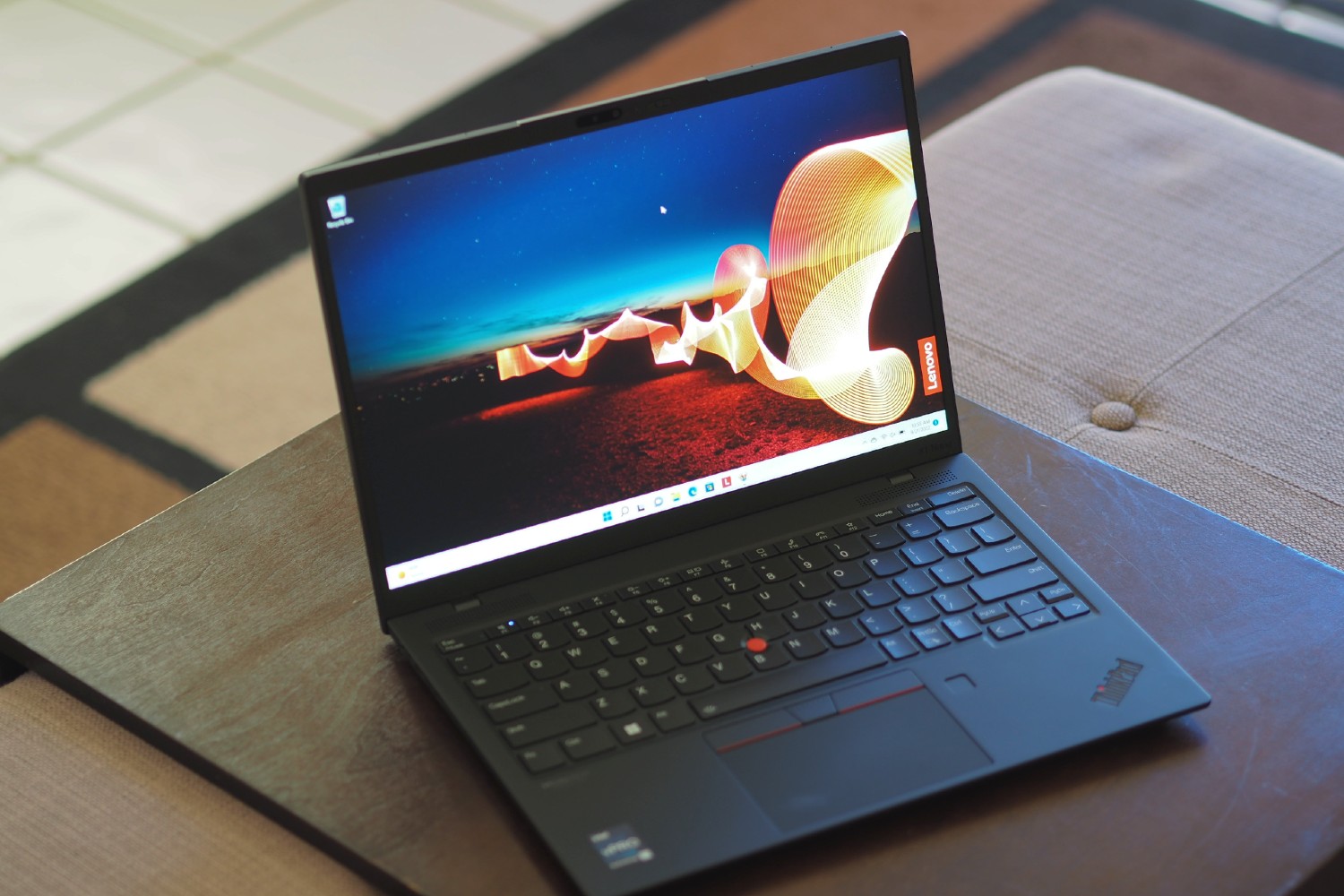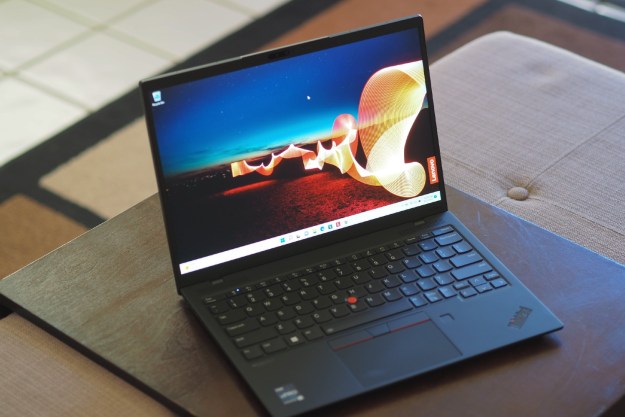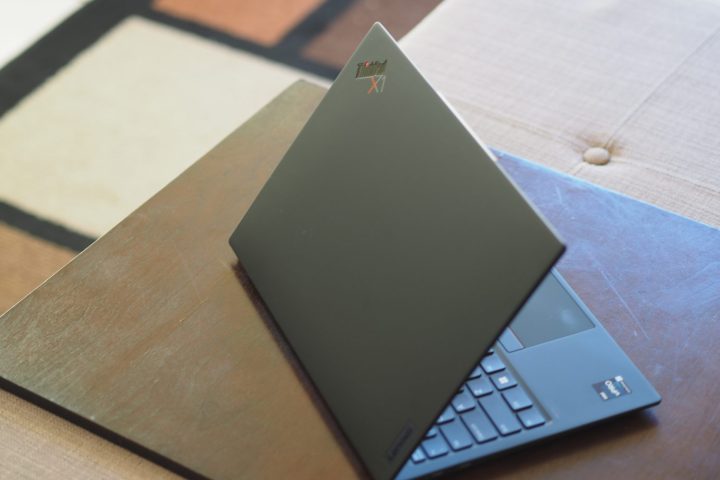Lenovo ThinkPad X1 Nano Gen 2 review: this tiny ThinkPad is still great
The Lenovo ThinkPad X1 Nano Gen 2 is small, powerful, and extremely well-built. It's aimed at business users.


Lenovo ThinkPad X1 Nano Gen 2 review: this tiny ThinkPad is still great
MSRP $2,300.00
Pros
Fast productivity performance Solid build quality Very good IPS display 1080p webcam Extensive privacy featuresCons
Battery life took a step back Keyboard is a little harsh ExpensiveThe ThinkPad X1 Nano is a lot of computer in a very tiny shell. Lenovo just released the laptop’s second generation, which features an update to Intel 12th-gen CPUs but otherwise maintains essentially the same design.
That’s OK, though, because the ThinkPad X1 Nano Gen 2 didn’t need much improvement. The new version is simply a much faster laptop that’s an even better tool for demanding productivity workers while maintaining the tiny form factor that made the previous generation so great. While Lenovo aims the ThinkPad at business users, this is one model that has mainstream appeal.
Specs
| Lenovo ThinkPad X1 Nano Gen 2 | |
| Dimensions | 11.55 inches x 8.19 inches x 0.58 inches |
| Weight | 2.13 pounds |
| Processor | Core i5-1240P Core i5-1250P vPro Core i7-1260P Core i7-1270P vPro Core i7-1280P vPro |
| Graphics | Intel Iris Xe |
| RAM | 16GB LPDDR5 RAM 32GB LPDDR5 RAM |
| Display | 13.0-inch 16:10 2K (2,160 x 1,350) IPS low-power 13.0-inch 16:10 2K IPS touch low-power |
| Storage | 256GB PCIe Gen4 SSD 512GB PCIe Gen4 SSD 1TB PCIe Gen4 SSD |
| Touch | Optional |
| Ports | 2 x USB-C with Thunderbolt 4 1 x 3.5mm audio jack 1 x Optional Nano-SIM slot |
| Wireless | Wi-Fi 6E and Bluetooth 5.2 Option 5G or LTE WWAN |
| Webcam | 1080p 1080p with IR camera for facial recognition and Computer Vision |
| Operating system | Windows 11 |
| Battery | 49.5 watt-hours |
| Price | $1,572+ |
A wide range of configurations are available with the ThinkPad X1 Nano Gen 2. The $1,572 entry-level model features a Core i5-1240P CPU, 16GB of LPDDR5 RAM, a 256GB PCIe Gen4 SSD, and a 13.0-inch 16:10 2K low-power IPS display. Notably, even this model has 16GB of RAM instead of 8GB. At the high end is a $2,527 configuration with a Core i7-1280P CPU, 32GB of RAM, a 1TB SSD, a brighter display, and 5G WWAN support.
My review unit, which lacked the 5G connectivity and used the lower-end display, came in at $2,300.
The vPro CPU affords access to enterprise security and manageability and is worth the investment for business users. All models have the same One-year warranty, which is disappointing for such an expensive laptop — although it’s the industry standard.
It’s as small as a ThinkPad can be
 Mark Coppock/Digital Trends
Mark Coppock/Digital TrendsThe ThinkPad X1 Nano Gen 2 is almost exactly the same size as its predecessor and weighs almost as little. It’s gained a few ounces, now weighing 2.13 pounds versus 1.99 pounds, but of course, that’s not enough to notice. What is noticeable is just how light the laptop really is. Where other 13-inch laptops like the Dell XPS 13 and XPS 13 Plus feel quite dense, the ThinkPad X1 Nano Gen 2 feels light and airy. It’s amazing what can be done with materials like carbon fiber and magnesium-aluminum. And the laptop isn’t just light; it’s thin as well at 0.58 inches.
The only dimensions where the ThinkPad X1 Nano Gen 2 isn’t particularly impressive is in width and depth. Despite its 13.0-inch 16:10 display that’s slightly smaller than the XPS 13 Plus’ 13.3-inch 16:10 panel, the ThinkPad is almost as wide and slightly deeper. That’s due to display bezels that aren’t as small as on the XPS 13 Plus. There’s nothing to complain about here, of course, but it’s important to note that Dell still wins out when it comes to tiny bezels.
The ThinkPad X1 Nano Gen 2 feels surprisingly robust for a laptop of its size.
If the ThinkPad X1 Nano Gen 2 were flimsy, then all that light weight and thinness would be wasted. Amazingly, it’s quite rigid, with a lid that doesn’t bend even under extreme pressure and a keyboard deck and chassis bottom that resist flexing. It’s as solid as the best 13-inch laptops around, an impressive feat considering that the materials used quite often result in laptops that bend, flex, and twist.
Look at the ThinkPad X1 Nano Gen 2 from a distance and you’ll have a tough time distinguishing it from its larger siblings. It sports the same black-on-black aesthetic with red accents in the logo on the lid and keyboard deck, the red TrackPoint nubbin in the middle of the keyboard, and the top edges of the TrackPoint buttons. Some configurations have a carbon fiber weave on the lid, but otherwise, the design is minimalistic and adheres to the ThinkPad look and feel. That extends to the soft-touch surface that’s comfortable to hold and for typing.

The keyboard is also the ThinkPad standard, albeit with less key spacing and slightly smaller, yet just as sculpted keycaps. The layout is the same, down to the left Fn and Ctrl keys that are reversed from the industry standard (and can be swapped in the BIOS). I found the mechanism a bit stiff, with plenty of travel but an abrupt bottoming action.
It wasn’t the most comfortable keyboard I’ve used, with HP’s Spectre and Dell’s XPS keyboards being much better. Lenovo has you covered when it comes to controlling the cursor, with both the TrackPoint nubbin and a small yet serviceable touchpad. Both work well. My review unit didn’t include a touch display, but the higher-end display does.
Understandably given the small chassis, the ThinkPad X1 Nano Gen 2’s connectivity is limited. There are two USB-C ports with Thunderbolt 4, a 3.5mm audio jack, and an optional Nano-SIM slot for 5G or LTE WWAN. Wireless connectivity also includes the latest standards with Wi-Fi 6E and Bluetooth 5.2.
A portable powerhouse?

Yes, I know, the ThinkPad X1 Nano Gen 2 can’t possibly be as fast as larger and thicker laptops. That’s entirely reasonable. And it’s not, with some obvious thermal throttling given the 28-watt 14-core/20-thread Core i7-1280P squeezed inside. But even so, it provided impressive performance considering how thin and light it is and thus how easy it is to carry around. I’ve reported both balanced and performance mode results in the table below, which was configurable by using an integration Lenovo built with the Windows 11 performance tuner.
The best comparison is the Dell XPS 13 Plus, which we reviewed with the same CPU. It’s also a thin machine, although not nearly as light, and surprisingly, the ThinkPad X1 Nano Gen 2 was the faster performer in most of our benchmarks. The Dell took the lead in our Handbrake test that encodes a 420MB video as H.265, but otherwise, the ThinkPad came out ahead. It was slower than the diminutive Asus ZenBook S 13 OLED running the AMD Ryzen 7 6800U, and it fell behind the Lenovo Slim 9i that was considerably larger and thicker.
Compared to the previous version, the Gen 2 model is in a different league entirely. The original ThinkPad X1 Nano used a low-power 15-watt quad-core CPU, and so that makes sense. But choosing a ThinkPad X1 Nano today requires far less of a performance compromise than before. You’ll find the new model fast enough for demanding productivity workflows, but not the best for creative applications. With integrated Intel Iris Xe graphics, it’s also not a gaming machine.
| Geekbench (single / multi) |
Handbrake (seconds) |
Cinebench R23 (single / multi) |
PCMark 10 Complete |
|
| Lenovo ThinkPad X1 Nano Gen 2 (Core i7-1280P) |
Bal: 1,493 / 8,668 Perf: 1,711 / 9,730 |
Bal: 126 Perf: 131 |
Bal: 1,575 / 7,595 Perf: 1,580 / 7,780 |
5,094 |
| Lenovo ThinkPad X1 Nano Gen 1 (Core i7-1160G7) |
Bal: 1,466 / 5,139 Perf: N/A |
Bal: 180 Perf: 188 |
Bal: 1,377 / 4,550 Perf: 1,382 / 4,562 |
4,600 |
| Dell XPS 13 Plus (Core i7-1280P) |
Bal: 1,316 / 8,207 Perf: N/A |
Bal: 127 Perf: 94 |
Bal: 1,311 / 6,308 Perf: 1,650 / 7,530 |
4,309 |
| Asus Zenbook S 13 OLED (Ryzen 7 6800U) |
Bal: 1,417 / 6,854 Perf: 1,404 / 7,223 |
Bal: 112 Perf: 111 |
Bal: 1,402 / 8,682 Perf: 1,409 / 8,860 |
5,647 |
| Lenovo Slim 9i (Core i7-1280P) |
Bal: 1,720 / 10,115 Perf: 1,726 / 11,074 |
Bal: 114 Perf: 95 |
Bal: 1,795 / 9,467 Perf: 1,824 / 11,301 |
5,442 |
| Apple MacBook Air M2 (Apple M2) |
Bal: 1,925/ 8,973 Perf: N/A |
Bal: 151 Perf: N/A |
Bal: 1,600 / 7,938 Perf: N/A |
N/A |
Battery life is another quality that can suffer from a small chassis. The ThinkPad X1 Nano Gen 2 has 49.5 watt-hours of battery capacity stuffed inside, which is a decent amount for a laptop with a smaller low-power display. But physics matters, and there’s only so much longevity you can squeeze out. The ThinkPad did well in our video test and in the PCMark 10 Applications battery test that’s the best indication of productivity battery life, but it was a little weak in our web-browsing test. Overall, you’ll approach a full day’s work with a light productivity load, but if you’re pushing things hard, you’ll want to make sure to have your charger nearby.
This is the one area where the second generation falls behind. The low-power CPU in the previous generation provided significantly more longevity. And the Apple MacBook Air M2 provides yet another level of battery life.
| Web browsing | Video | |
| Lenovo ThinkPad X1 Nano Gen 2 (Core i7-1280P |
6 hours, 13 minutes | 13 hours, 38 minutes |
| Lenovo ThinkPad X1 Nano Gen 1 (Core i7-1160G7) |
10 hours, 15 minutes | 18 hours, 2 minutes |
| Dell XPS 13 Plus (Core i7-1280P) |
8 hours, 0 minutes | 9 hours, 20 minutes |
| Asus Zenbook S 13 OLED (Ryzen 7 6800U) |
8 hours, 4 minutes | 13 hours, 13 minutes |
| Apple MacBook Air M2 (Apple M2) |
17 hours, 59 minutes | 21 hours, 9 minutes |
Tiny but still comfortable
Small laptops like the ThinkPad X1 Nano Gen 2 often come with compromises. Low-resolution displays of suspect quality, cramped keyboards, and tiny touchpads are just a few. Fortunately, Lenovo avoided those pitfalls.
To begin with, the keyboard is the ThinkPad standard, albeit with a little less key spacing and slightly smaller yet just as sculpted keycaps. The layout is the same, down to the left Fn and Ctl keys that are reversed from the industry standard (and can be swapped in the BIOS). I found the mechanism a bit stiff, with plenty of travel but an abrupt bottoming action. It wasn’t the most comfortable keyboard I’ve used, with HP’s Spectre and Dell’s XPS keyboards being much better. I maintained my usual typing speed and didn’t feel like I was typing on a particularly small keyboard.
The display is more than good enough for handing the average spreadsheet, video, or website.
Lenovo has you covered when it comes to controlling the cursor, with both the TrackPoint nubbin and a smaller yet serviceable touchpad. Both worked well. My review unit didn’t include a touch display, but the higher-end display is touch-enabled.
Two display options are available with the ThinkPad X1 Nano Gen 2, both low-power 13.0 inch 2K 16:10 displays. One is touch-enabled with a higher brightness rating and the other, my review unit, is non-touch and with a slightly lower brightness rating.

The previous model also equipped a similar IPS display, with the same resolution. According to my colorimeter, the display has roughly the same premium-display average color gamut as the previous generation, with improved accuracy. Brightness is higher and contrast has been dramatically improved. Overall, the display is more than good enough for productivity workers and media consumers, while creators will find the colors too narrow for serious work.
| Brightness (nits) |
Contrast | sRGB gamut | AdobeRGB gamut | Accuracy DeltaE (lower is better) |
|
| Lenovo ThinkPad X1 Nano Gen 2 (IPS) |
446 | 1,460:1 | 99% | 76% | 1.21 |
| Lenovo ThinkPad X1 Nano Gen 1 (IPS) |
414 | 980:1 | 98% | 74% | 1.73 |
| Asus Zenbook S 13 OLED (OLED) |
366 | 25,560:1 | 100% | 96% | 1.0 |
| Lenovo ThinkBook 13x (IPS) |
417 | 1,430:1 | 100% | 76% | 0.97 |
| Dell XPS 13 (IPS) |
420 | 1,360:1 | 100% | 79% | 1.21 |
Two upward-firing speakers provide the audio, and I found the sound to be just OK. The volume wasn’t very high, and there was some distortion when playing at 100%. Mids and highs were fine but there was zero bass. Keep some headphones handy.
Lenovo builds in a few creature comforts that enhance the ThinkPad X1 Nano Gen 2’s privacy as well as its appeal to hybrid workers. The webcam is 1080p and provides a detailed image in all lighting conditions, and the IR camera supports Windows 11 Hello passwordless login. There’s also a fingerprint reader on the palm rest to the right of the touchpad.
An ultra-wideband radar sensor provides enhanced support for Lenovo’s user presence-sensing technology, providing for Zero Touch Lock that puts the laptop to sleep when the user leaves and Zero Touch Login that wakes the laptop up and automatically logs in when the user returns. The display also dims when the user is looking in a different direction. Finally, there’s a physical shutter for blocking the webcam for additional privacy.
The smallest ThinkPad is one of the best
The ThinkPad X1 Nano Gen 2 is a small laptop with a solid build quality and fast productivity performance. It’s a significant improvement over the first generation, with a better display to go with the increase in speed. There’s a significant drop in battery life, though, which might matter to some users.
It’s a 13-inch laptop that competes strongly against others in its class like the Dell XPS 13 Plus and the Asus ZenBook S 13 OLED. It’s expensive, but if you’re looking for a laptop that’s incredibly easy to carry around, the ThinkPad X1 Nano Gen 2 fits the bill.

 AbJimroe
AbJimroe 






























